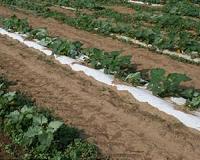 |
West Lafayette, IN (SPX) Jan 04, 2011 Traditional turfgrass management programs rely heavily on the use of synthetic pesticides and fertilizers. In response to increased public scrutiny and legislation, organic and biological alternatives are becoming more accepted, but research indicates that these alternatives have not been widely adopted by either homeowners or the lawn care industry. Results of a new study that compared common but disparate turfgrass management approaches may help lawn care professionals to evaluate, market, and implement alternative management programs. Purdue University researchers reported on a field study that evaluated and compared the aesthetic and economic characteristics of four turfgrass fertility and pesticide programs. In a recent issue of HortTechnology Victoria A. Caceres, Cale A. Bigelow, and Douglas S. Richmond noted that the reasons that homeowners and professionals do not adopt organic alternatives "primarily revolve around a combination of high aesthetic standards and a perceived lack of reliability or cost effectiveness associated with biologically based alternatives." For the study, the researchers compared four turfgrass fertility and pesticide programs in an effort to provide a framework for lawn care professionals. Programs included a consumer program (CP), an integrated pest management program (IPMP), a natural organic program (NOP), and a no-input program (NIP). The researchers measured aesthetic characteristics such as canopy greenness and turfgrass quality (color, density, and uniformity) and determined economic aspects by recording the cost of materials and labor associated with each fertility and pesticide program. "Results of the experiments showed that all programs significantly improved visual appearance compared with the no-input program (NIP), and, although the integrated pest management program and consumer programs consistently had the highest ratings, the natural organic program produced lawns of similar quality on the majority of rating dates", stated Purdue's Caceres. "The no-input program also resulted in canopy greenness levels similar to or significantly greater than those provided by the IPMP and CP on most dates. Aside from the NIP, the lowest total maintenance costs were associated with the IPMP during both study years." Although homeowners and professionals still have choices when it comes to turfgrass management, results of the study may help to clarify some of the impacts and potential benefits associated with different approaches. The researchers added that "the results highlight how incorporation of scouting into different fertility and pesticide programs may provide short-term economic benefits without any significant aesthetic impacts."
Share This Article With Planet Earth
Related Links American Society for Horticultural Science Farming Today - Suppliers and Technology
 Paper Mulches Evaluated For Commercial Vegetable Production
Paper Mulches Evaluated For Commercial Vegetable ProductionLexington KY (SPX) Jan 04, 2011 Polyethylene mulches, used widely in commercial vegetable production to improve crop yields and produce quality, have distinct disadvantages. Disposal options are limited, and plastic mulches often end up in landfills, being burned, or disposed of illegally. Recycling polyethylene mulches is also a challenge; the mulches used in large-scale vegetable production are contaminated with too mu ... read more |
|
| The content herein, unless otherwise known to be public domain, are Copyright 1995-2010 - SpaceDaily. AFP and UPI Wire Stories are copyright Agence France-Presse and United Press International. ESA Portal Reports are copyright European Space Agency. All NASA sourced material is public domain. Additional copyrights may apply in whole or part to other bona fide parties. Advertising does not imply endorsement,agreement or approval of any opinions, statements or information provided by SpaceDaily on any Web page published or hosted by SpaceDaily. Privacy Statement |